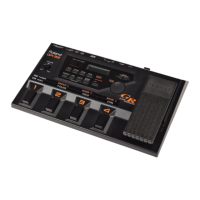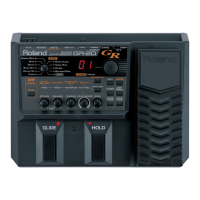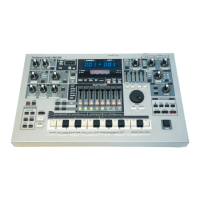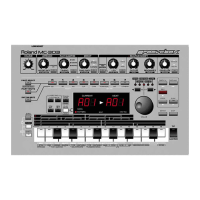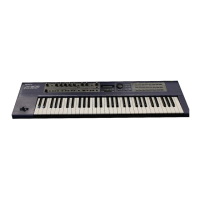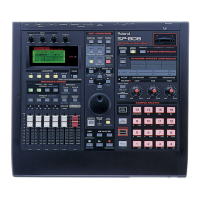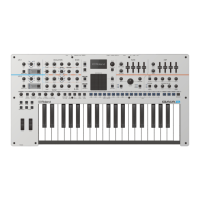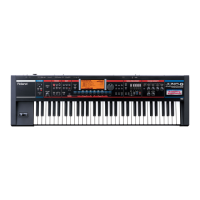nU1 to nU5 (Narrow Wah)
This compresses the tone difference from stepping
on and releasing the pedal to half the range of the
normal wah (UA1 to 5). In all other actions, it is
absolutely identical to UA1 to 5.
-U1 to -U5 (Reverse Wah 1 to 5)
This reverses the tones from stepping on and
releasing the pedal in normal wah (UA1 to 5) (i.e.
step → dark sound, release → bright).
-b1 to -b5 (Reverse Brightness 1 to 5)
This reverses the tones from stepping on and
releasing the pedal in the brightness setting (b1 to
5) (i.e. step → dark sound, release → bright).
-n1 to -n5 (Reverse Narrow 1 to 5)
This reverses the tones from stepping on and
releasing the pedal in Narrow (n1 to 5) (i.e. step →
dark sound, release → bright).
Mod (Modulation)
When you select this setting, as you step on the
pedal, then rather than a wah-type effect, a deep
vibrato (wavering pitch) effect is added. Differing
from the mood created by playing finger vibrato
on the guitar, it gives a mechanical, synthesizer-
sounding vibrato.
The speed and depth of the vibrato you get with
this function is predetermined for each tone.
Furthermore, when the pedal is pressed, “Mod,”
not “UAH” appears in the display when “Mod” is
selected.
✽
If you use wah once, the sound from a patch with a muf-
fled sound may continue, or some other kind of peculiar-
ity may change, even after releasing the wah pedal. If
this happens, switch to another patch, and then call up
the desired patch again to return to the original sound.
✽
When the wah is “closed,” that is, the sound of the wah
effect is too dark (or muffled), switch WAH TYPE to
either “nU1 to 5” or “-n1 to 5,” and adjust this by
changing the Brightness (p. 33) setting.
✽
The application of wah-type effects varies with the select-
ed tone.
46
Selecting Pitch Glide Type (GLIDE TYPE)
With the Pitch Glide you get by pressing pedal 2,
there are nine different ways to have the pitch change
width and speed, with both up and down patterns
prepared.
<Selecting Pitch Glide Type>
1. Select the patch whose effect type you want to
change, and press [EDIT/PLAY] to go into the
Edit mode.
2. Set the EDIT TARGET dial to FOOT PEDAL, and
the PARAMETER SELECT dial to “B” (GLIDE
TYPE).
3. When you press the [+] and [-] buttons, the display
changes. (Displays show: dn9, dn8, ..., dn1, uP1,
uP2,..., and uP9. For more on the effects that you
can get with each setting, refer to ◆.)
4. When you have selected the type, switch the
PARAMETER SELECT dial to “WRITE PATCH?”,
and press the [+] and [-] buttons simultaneously to
write the patch.
➼
When saving to another patch number, before step 4,
turn the PARAMETER SELECT dial to “WRITE
TO...”, and use the [+] and [-] buttons to designate a
patch number as the destination.
➼
When making settings, play the guitar while pressing
pedal 1 to try the effect.
◆ Selectable Effect Variations from Step 3
Below are the nine types of effect you can select from.
These have been set as both “pitch up” and “pitch
down,” giving you eighteen effects to choose from.
For example, “Up Type ‘5’” is indicated by “uP5” and
“Down Type ‘3’” by “dn3.”
uP1 (dn1)
When the pedal is pressed, the pitch changes con-
tinuously only by a perfect fourth. Release the
pedal to return to the original pitch.
uP2 (dn2)
Just as in uP1 (dn1), the pitch change is a perfect
fourth, but the time it takes to make the change is a
little longer.
uP3 (dn3)
When the pedal is pressed, the pitch changes con-
tinuously only by a perfect fifth. Release the pedal
to return to the original pitch.

